The Waterstops Market is estimated to be valued at USD 2.4 billion in 2025 and is projected to reach USD 4.0 billion by 2035, registering a compound annual growth rate (CAGR) of 5.4% over the forecast period.
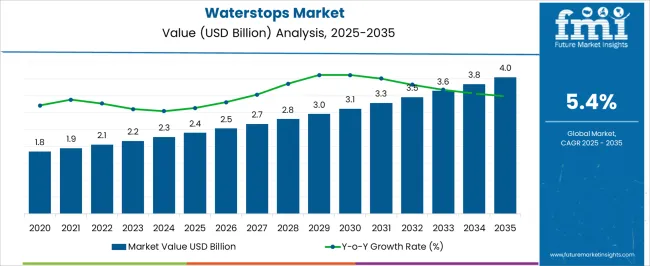
| Metric | Value |
|---|---|
| Waterstops Market Estimated Value in (2025 E) | USD 2.4 billion |
| Waterstops Market Forecast Value in (2035 F) | USD 4.0 billion |
| Forecast CAGR (2025 to 2035) | 5.4% |
The Waterstops market is witnessing sustained growth, supported by the increasing demand for durable sealing solutions in concrete structures that are exposed to water ingress. Rising investments in infrastructure projects such as tunnels, dams, water treatment plants, and underground constructions are driving market expansion. The need to ensure long-term structural integrity, prevent leakage, and comply with stringent construction safety standards is further enhancing adoption.
Waterstops are being increasingly integrated during concrete joint design to provide reliable sealing under high-pressure water exposure. Advancements in materials, including flexible PVC, thermoplastic elastomers, and hydrophilic compounds, are enabling improved performance and adaptability to diverse environmental conditions. Governments and private stakeholders are prioritizing sustainable and resilient construction practices, which is boosting demand for high-quality waterstops.
Additionally, innovations in installation technologies and accessories are reducing project time and labor requirements, making these solutions more cost-effective With rapid urbanization, large-scale infrastructure upgrades, and emphasis on durable water management systems, the waterstops market is expected to remain on a strong growth trajectory over the coming decade.
The waterstops market is segmented by material, waterstops types, accessories, and geographic regions. By material, waterstops market is divided into Flexible Polyvinyl Chloride PVC, Polyethylene (PE), Carbon Steel, and Others. In terms of waterstops types, waterstops market is classified into External Waterstops, Internal Waterstops, and Expansion Waterstops. Based on accessories, waterstops market is segmented into Waterstops Welding Irons, Hog Rings, Hog Rings Pliers, and Others. Regionally, the waterstops industry is classified into North America, Latin America, Western Europe, Eastern Europe, Balkan & Baltic Countries, Russia & Belarus, Central Asia, East Asia, South Asia & Pacific, and the Middle East & Africa.
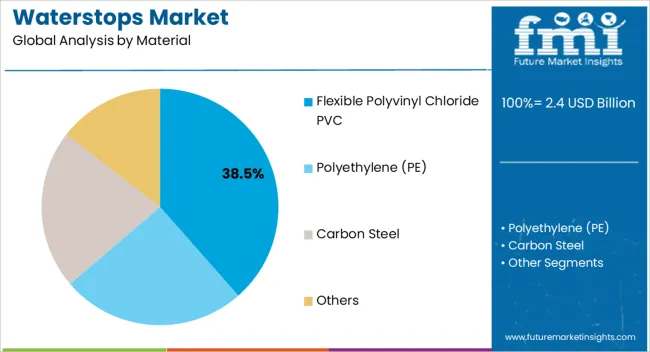
The flexible polyvinyl chloride PVC segment is projected to account for 38.5% of the Waterstops market revenue in 2025, positioning it as the leading material type. Growth is being driven by the segment’s high flexibility, chemical resistance, and proven durability under diverse construction environments. PVC waterstops are widely preferred in tunnels, basements, dams, and reservoirs due to their ability to accommodate structural movements while maintaining effective sealing.
Their ease of installation, cost efficiency, and compatibility with a wide range of concrete structures reinforce their adoption in both commercial and industrial applications. Manufacturers are increasingly offering PVC waterstops with enhanced formulations to withstand extreme weather and aggressive chemicals, which further strengthens their suitability for demanding projects.
Additionally, the segment benefits from strong availability and established supply networks, which support large-scale deployments in infrastructure and utility projects As construction activity continues to expand globally, the flexible PVC material segment is expected to maintain its leadership, driven by reliability, adaptability, and affordability.
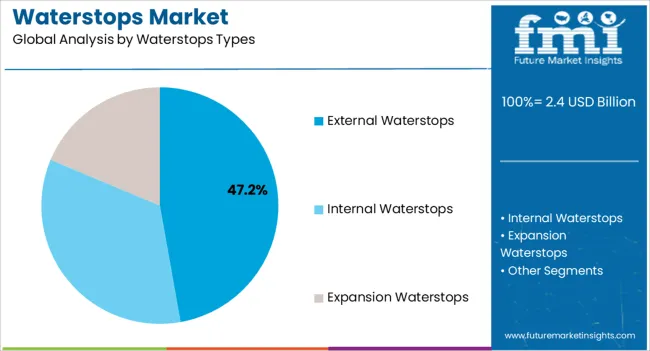
The external waterstops type segment is anticipated to capture 47.2% of the Waterstops market revenue in 2025, making it the dominant segment by type. This growth is supported by the segment’s effectiveness in providing sealing solutions for construction joints exposed to direct water pressure, such as those in foundations, retaining walls, and water tanks. External waterstops are installed outside the concrete joint, ensuring maximum contact with potential seepage areas, which enhances their performance in preventing leakage.
Their adaptability to a wide range of project requirements, coupled with robust design flexibility, makes them highly preferred for critical infrastructure projects. Continuous improvements in manufacturing processes have resulted in products that are easier to install and maintain, reducing overall project costs.
Additionally, the ability of external waterstops to work in high-pressure environments ensures their application across diverse industries including utilities, transportation, and water management With growing demand for reliable and long-lasting sealing solutions, external waterstops are expected to continue dominating the market in the years ahead.
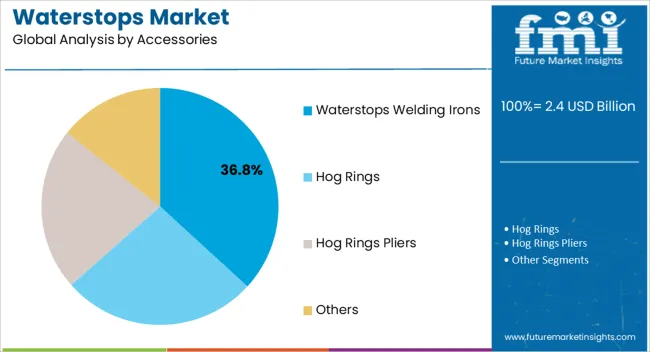
The waterstops welding irons segment is expected to hold 36.8% of the Waterstops market revenue in 2025, emerging as the leading accessory category. This dominance is attributed to the growing need for efficient and precise installation of waterstops, where welding irons play a critical role in joining and sealing PVC profiles. The use of welding irons ensures that joints between waterstop sections remain strong and leak-proof, thereby enhancing the durability and functionality of the overall sealing system.
Contractors and construction firms are increasingly relying on high-performance welding irons to reduce errors and improve productivity during large-scale installations. Modern welding irons also offer better energy efficiency and user-friendly features, reducing labor requirements and project timelines.
Their essential role in ensuring the integrity of waterstop systems across diverse applications such as tunnels, reservoirs, and basements has reinforced their market importance As infrastructure development accelerates globally and demand rises for durable sealing solutions, waterstops welding irons are expected to remain a vital accessory segment, supporting consistent market leadership.
Waterstops are elements of concrete structure, which are used to prevent the flow of water. While running through or embedded in the concrete joints, waterstops provide a fluid-tight diaphragm. Waterstops are manufactured from a wide variety of materials depending upon its purpose. The materials include extruded plastic, stainless steel and copper.
Waterstops are coated with polymeric coatings. Numerous fitting types and ongoing developments in the sector are expected to increase the demand of waterstops market, globally.
Different types of waterstops are used depending upon the application areas, which include walls, under waterstops and external waterstops. The global waterstops market trend is shifting from using waterstops made up of stainless steels material to flexible polymer material.
Flexible and syntactic waterstops are durable and corrosion free. It can also resist the fluctuating water flow. All these factors fuel the growth of global waterstops market.
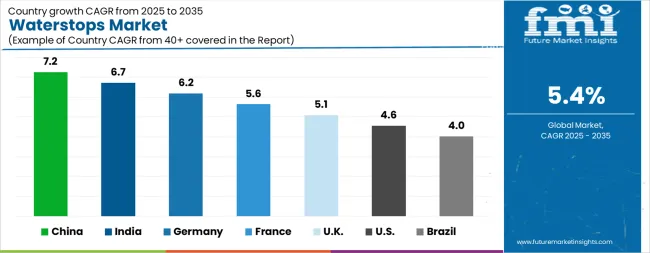
| Country | CAGR |
|---|---|
| China | 7.2% |
| India | 6.7% |
| Germany | 6.2% |
| France | 5.6% |
| UK | 5.1% |
| USA | 4.6% |
| Brazil | 4.0% |
The Waterstops Market is expected to register a CAGR of 5.4% during the forecast period, exhibiting varied country level momentum. China leads with the highest CAGR of 7.2%, followed by India at 6.7%. Developed markets such as Germany, France, and the UK continue to expand steadily, while the USA is likely to grow at consistent rates. Brazil posts the lowest CAGR at 4.0%, yet still underscores a broadly positive trajectory for the global Waterstops Market. In 2024, Germany held a dominant revenue in the Western Europe market and is expected to grow with a CAGR of 6.2%. The USA Waterstops Market is estimated to be valued at USD 827.3 million in 2025 and is anticipated to reach a valuation of USD 1.3 billion by 2035. Sales are projected to rise at a CAGR of 4.6% over the forecast period between 2025 and 2035. While Japan and South Korea markets are estimated to be valued at USD 111.3 million and USD 77.0 million respectively in 2025.
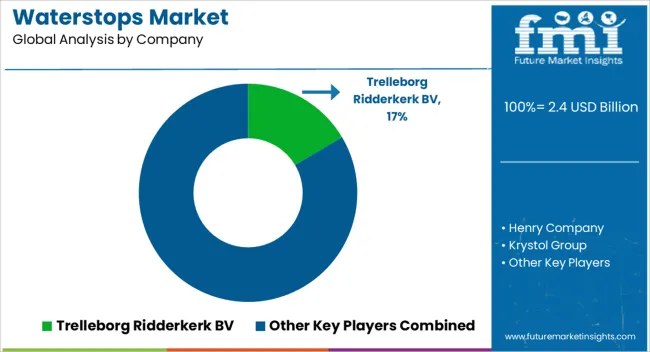
| Item | Value |
|---|---|
| Quantitative Units | USD 2.4 Billion |
| Material | Flexible Polyvinyl Chloride PVC, Polyethylene (PE), Carbon Steel, and Others |
| Waterstops Types | External Waterstops, Internal Waterstops, and Expansion Waterstops |
| Accessories | Waterstops Welding Irons, Hog Rings, Hog Rings Pliers, and Others |
| Regions Covered | North America, Europe, Asia-Pacific, Latin America, Middle East & Africa |
| Country Covered | United States, Canada, Germany, France, United Kingdom, China, Japan, India, Brazil, South Africa |
| Key Companies Profiled | Trelleborg Ridderkerk BV, Henry Company, Krystol Group, Emagineered Solutions Inc., Foshan Nanhai Fufujing Plastic Hardware Company Limited, BoMetals, Inc., Greenstreak group, Inc., Visqueen Building Products, Hengshui Jingtong Rubber Co., Ltd., and Mapei Construction Products India Pvt Ltd. |
The global waterstops market is estimated to be valued at USD 2.4 billion in 2025.
The market size for the waterstops market is projected to reach USD 4.0 billion by 2035.
The waterstops market is expected to grow at a 5.4% CAGR between 2025 and 2035.
The key product types in waterstops market are flexible polyvinyl chloride pvc, polyethylene (pe), carbon steel and others.
In terms of waterstops types, external waterstops segment to command 47.2% share in the waterstops market in 2025.






Our Research Products

The "Full Research Suite" delivers actionable market intel, deep dives on markets or technologies, so clients act faster, cut risk, and unlock growth.

The Leaderboard benchmarks and ranks top vendors, classifying them as Established Leaders, Leading Challengers, or Disruptors & Challengers.

Locates where complements amplify value and substitutes erode it, forecasting net impact by horizon

We deliver granular, decision-grade intel: market sizing, 5-year forecasts, pricing, adoption, usage, revenue, and operational KPIs—plus competitor tracking, regulation, and value chains—across 60 countries broadly.

Spot the shifts before they hit your P&L. We track inflection points, adoption curves, pricing moves, and ecosystem plays to show where demand is heading, why it is changing, and what to do next across high-growth markets and disruptive tech

Real-time reads of user behavior. We track shifting priorities, perceptions of today’s and next-gen services, and provider experience, then pace how fast tech moves from trial to adoption, blending buyer, consumer, and channel inputs with social signals (#WhySwitch, #UX).

Partner with our analyst team to build a custom report designed around your business priorities. From analysing market trends to assessing competitors or crafting bespoke datasets, we tailor insights to your needs.
Supplier Intelligence
Discovery & Profiling
Capacity & Footprint
Performance & Risk
Compliance & Governance
Commercial Readiness
Who Supplies Whom
Scorecards & Shortlists
Playbooks & Docs
Category Intelligence
Definition & Scope
Demand & Use Cases
Cost Drivers
Market Structure
Supply Chain Map
Trade & Policy
Operating Norms
Deliverables
Buyer Intelligence
Account Basics
Spend & Scope
Procurement Model
Vendor Requirements
Terms & Policies
Entry Strategy
Pain Points & Triggers
Outputs
Pricing Analysis
Benchmarks
Trends
Should-Cost
Indexation
Landed Cost
Commercial Terms
Deliverables
Brand Analysis
Positioning & Value Prop
Share & Presence
Customer Evidence
Go-to-Market
Digital & Reputation
Compliance & Trust
KPIs & Gaps
Outputs
Full Research Suite comprises of:
Market outlook & trends analysis
Interviews & case studies
Strategic recommendations
Vendor profiles & capabilities analysis
5-year forecasts
8 regions and 60+ country-level data splits
Market segment data splits
12 months of continuous data updates
DELIVERED AS:
PDF EXCEL ONLINE

Thank you!
You will receive an email from our Business Development Manager. Please be sure to check your SPAM/JUNK folder too.
Chat With
MaRIA